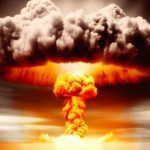 Mysteries
Mysteries  Mysteries
Mysteries  History
History 10 Surprising Stories About the Texas Rangers
 Humans
Humans 10 Philosophers Who Were Driven Mad by Their Own Theories
 Miscellaneous
Miscellaneous 10 Video-Game-Worthy Weapons and Armors from History
 Weird Stuff
Weird Stuff 10 Psychics Who Accurately Predicted Wartime Events
 The Arts
The Arts 10 Pieces of Art Inspired by a Broken Heart
 Health
Health 10 Science Fiction-Sounding New Medical Treatments
 History
History 10 Surprising Facts About the Father of Submarine Warfare
 Space
Space Ten Astonishing New Insights into Alien Worlds
 Weird Stuff
Weird Stuff 10 Bizarre Summer Solstice Rituals Still Practiced Today
 Mysteries
Mysteries Top 10 Haunting Facts About the Ghost Ship MV Alta
 History
History 10 Surprising Stories About the Texas Rangers
 Humans
Humans 10 Philosophers Who Were Driven Mad by Their Own Theories
Who's Behind Listverse?

Jamie Frater
Head Editor
Jamie founded Listverse due to an insatiable desire to share fascinating, obscure, and bizarre facts. He has been a guest speaker on numerous national radio and television stations and is a five time published author.
More About Us Miscellaneous
Miscellaneous 10 Video-Game-Worthy Weapons and Armors from History
 Weird Stuff
Weird Stuff 10 Psychics Who Accurately Predicted Wartime Events
 The Arts
The Arts 10 Pieces of Art Inspired by a Broken Heart
 Health
Health 10 Science Fiction-Sounding New Medical Treatments
 History
History 10 Surprising Facts About the Father of Submarine Warfare
 Space
Space Ten Astonishing New Insights into Alien Worlds
 Weird Stuff
Weird Stuff 10 Bizarre Summer Solstice Rituals Still Practiced Today
10 Celebrated Scientists Who Developed Deadly Weapons
Scientists and thinkers as far back as ancient times have helped invent, discover, and improve all manner of deadly instruments of war. The Manhattan Project to build the atomic bomb might be the best-known example, and while it is remarkable for its lethal success and the caliber of scientists who worked on it, it is far from the only one. Many scientists have willingly helped create weapons, while for others, weapons were a tragic consequence of their work that they never intended. Here are ten examples of famous scientists, engineers, and inventors outside of the Manhattan Project who helped develop deadly weapons.
Related: Top 10 Ways Science Predicts the World Will End
10 Archimedes
This famous ancient Greek scientist and mathematician was born in 287 BC and lived in the city of Syracuse. Perhaps best remembered for his contributions to arithmetic, geometry, and hydraulics, he also applied his principles to the development of weapons the city could use to defend itself from invasion by the Romans. One such weapon was the catapult. This ingenious device could hurl rocks weighing as much as 700 pounds (317.5 kilograms) at the Roman army, along with firing a barrage of arrows. He might have invented the catapults used by Syracuse, but they may not have been the first. The Roman army under Marcellus was also reported to have had the means to launch projectiles at great range.
However, another invention by Archimedes would be named after him. The Archimedes claw was a device that could latch onto enemy ships and overturn them using the power of leverage. Archimedes is also said to have used mirrors reflecting the sun to create a death ray that set Roman ships on fire. According to Leonardo Da Vinci, he invented a canon that used rapidly-heated steam to launch incendiary projectiles.[1]
9 Galileo
When the Italian astronomer designed a better telescope, looking into space was not the only use he had in mind. Galileo’s telescope was twice as powerful as any other in its day, and this offered Venetian soldiers the advantage of seeing without being seen. Galileo wrote to the Doge of Venice to see if he wanted the telescopes for his forces. The Doge did not want them, but he rewarded Galileo for his work.
Galileo later improved his design to make it even stronger, leading to his astronomical discoveries. However, he had more ideas for the military. He later designed a compass soldiers could use to increase the accuracy of cannon fire.[2]
8 Leonardo Da Vinci
A fantastic artist who painted iconic pictures like the Mona Lisa and the Last Supper, Leonardo Da Vinci was also a talented engineer who sketched plans for plenty of weapons. Some even resemble instruments used in modern warfare. He was obligated to do this under the patronage of the Duke of Milan because Italy, in his lifetime, existed less as a unified country and more as a collection of conflicting city-states. As such, it was not unusual for wars to break out.
Among his inventions was an early example of a tank that held a crew of eight and several light cannons inside a reinforced metal shell. It could move and shoot in any direction. But Da Vinci is believed to have designed this with a deliberate flaw in the crank mechanism, which made it less easy to move and, therefore, less deadly. Da Vinci did not want to design weapons, so he cleverly fulfilled his obligation to his patron with a flawed design that never ended up being made.
However, a weapon of his that was made and possibly even used in battle was a triple-barrelled cannon designed for rapid fire. Although it appeared to have been abandoned by the troops, it was essentially a precursor to the modern machine gun.[3]
7 Alfred Nobel
Now known for the Peace Prize bearing his name, it is ironic that Alfred Nobel’s inventions made big contributions to modern warfare. While his father invented the first sea mines for use in the Crimean War, Nobel’s best-known invention, dynamite, was created for industrial use. However, it was soon being used by soldiers on both sides of the Franco-Prussian War.
While the use of dynamite in the war was unintended, Nobel had no such excuse when he developed ballistite in 1888. This was smokeless gunpowder, which he sold to Italy. He claimed he worked on it not to help soldiers but because the theoretical aspects interested him. Had he lived longer, he might have worked on weapons of mass destruction. Although a proponent of peace, Nobel’s letters to the Austrian author Bertha von Suttner proposed peace be achieved by developing a weapon so powerful it would act as a deterrent to all civilized nations.[4]
6 Marie Curie
History’s most famous female scientist earned the Nobel Prize for her discovery of two elements that would both have military applications: radium and polonium. Radium, which was more stable and could glow, was used in self-luminous paint. This was applied to watches, aircraft switches, and instrument dials, including those in military vehicles. People stopped using it in the 1960s and 1970s when they realized it was dangerous to their health.
Polonium, Curie’s other discovery, was too unstable to have many uses, but it found one in the 21st century: assassination. If it gets inside the body, its radiation is so deadly that an amount the size of a grain of salt can kill an adult. It also takes effect gradually, so assassins have time to escape. This was the fate of former Russian spy Alexander Litvinenko, who drank tea laced with polonium at a London hotel in 2006, dying in the hospital weeks later.[5]
5 Thomas Edison
Thomas Edison was such a prolific inventor that it is not much of a surprise to find weapons among his many ideas, which famously included light bulbs, the phonograph, and the motion-picture camera. After publicly urging the armed forces to prepare in case they entered the First World War, he was made head of the Naval Consulting Board. He had helped the Navy before during the Spanish-American War. The board reviewed and tested ideas submitted to the armed forces as well as contributed their own.
Edison personally worked on 49 ideas during the war. Many were defensive in nature and focused on detecting incoming threats or avoiding detection by the enemy. But he also helped develop a missile that could be shot into the sea without ricocheting off the surface so U.S. destroyers could attack German U-boats. Another weapon he worked on was an artillery shell for the army that exploded in mid-air, making it more destructive.[6]
4 Nikola Tesla
In the final years of his life, long after finding success and fame with his work on alternating current and other electrical inventions, Nikola Tesla worked on one of his most highly anticipated projects: a death ray. Well, that is what the press called it. He called it the “teleforce.” A New York Times headline announced the project in 1915, proclaiming it would shoot Thor-like bolts of energy, but instead of electricity, it would produce beams of metal ions traveling 270,000 mph (434,522 km/h).
By 1939, when the war broke out in Europe, Tesla still had not produced evidence of a working death ray. But he had once claimed it could shoot down planes from 250 miles (386 kilometers) away. The U.S. government figured that was an advantage that could really help them and sought Tesla out, but then, Tesla was found dead in 1943.
As the war was in full swing, the government seized Tesla’s notes and papers and had them reviewed by a physicist. It was determined that Tesla’s ideas for the death ray were speculative and not workable. The concept of a death ray was still compelling to some officials, and Tesla’s work inspired further efforts to develop one under the top-secret Project Nick and later Reagan’s Strategic Defense Initiative, nicknamed Star Wars.[7]
3 Fritz Haber
Fritz Haber may have had one of the most morally complex scientific careers in history, even giving the Manhattan Project’s Oppenheimer a run for his money. Haber made his name as a scientist by solving one of the great challenges of the late 19th and early 20th centuries: feeding growing populations. He helped develop the Haber-Bosch process, which synthesizes ammonia for fertilizer, allowing it to be produced in huge quantities and helping more crops to grow, offering relief from famine and food scarcity. Some sources claim as many as two out of five people living today owe their lives to this discovery, considered by some to be the most important of the 20th century.
However, the process was also useful for making weapons. During WWI, Haber wanted to prove himself as a German patriot, so he pioneered the use of chlorine gas as a weapon. After the war, he successfully produced pesticide gases, but in 1933, he was expelled from his research institute for being Jewish. He died the next year, and it was not long before he was joined by members of his family. The Nazis used his research to develop the Zyklon process, which they used to murder millions of Jews in their death camps.[8]
2 Robert H. Goddard
Robert H. Goddard was an American physicist and inventor considered the father of modern rocketry. Although he lived in the late 19th and early 20th centuries, he foresaw the possibility of space travel and how it could be made a reality by using rockets. By 1914, he had begun patenting rocket designs. He would go on to patent over 200 in his lifetime. I
n 1926, he successfully proved the concept of liquid-fueled rockets when he launched the first one ever. It only reached 41 feet (12.5 meters), but by 1941, Goddard’s rockets could ascend 9,000 feet (2,743 meters) into the air. He tried to take his idea to the military for use in WWII. But they turned him down when they could not see how his work would be useful, although he ended up assisting the Navy with research. On the other hand, the Germans appeared to take a keen interest in Goddard’s research and incorporated several of his ideas into their V-2 ballistic missiles.[9]
1 Louis Fieser
Louis Fieser and his wife Mary were organic chemists. They synthesized compounds that exist in nature in order to study them. Among their accomplishments, they successfully synthesized cortisone, a steroid hormone, and vitamin K. During the Second World War, they tried to synthesize quinine, a malaria drug used by soldiers in the Pacific that was in short supply. However, none of the Fiesers’ synthesized compounds ever worked to treat malaria.
But Louis Fieser had another project during the war, one which was very successful. So much so that in 1972, he wrote to President Nixon asking for his invention to be banned. It was a combination of naphthenate and palmitate, which jelled together to produce a powerful incendiary. It was highly effective, easy to make, and did not spoil quickly. Fieser called it napalm.
Fieser meant for it to be used strategically to burn down buildings and structures. It went into use in 1942 and was, unfortunately, widely used in American conflicts in the 20th century, most controversially in Vietnam. Fieser claimed that while he was not ashamed of creating napalm, he strongly objected to using it on people. He believed this was happening in Vietnam, prompting him to write to President Nixon.[10]








